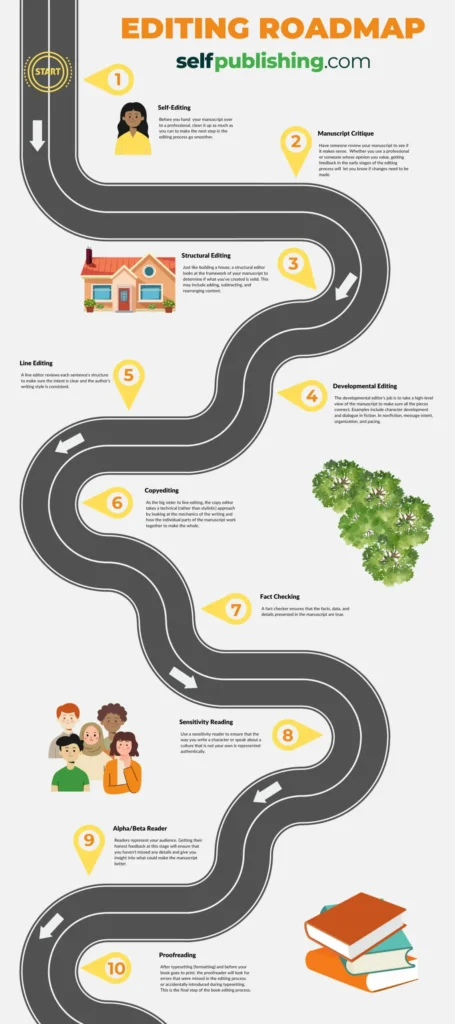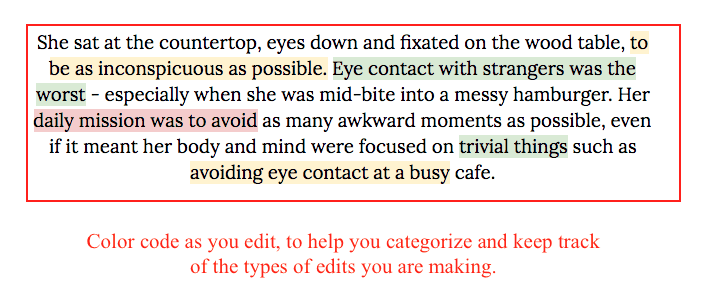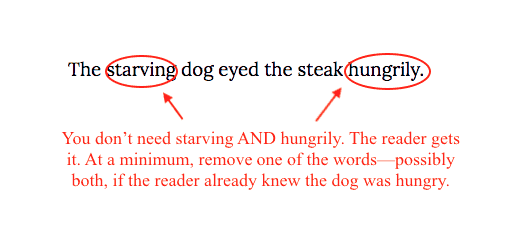You’ve done it! You’ve completed a draft of your manuscript and are well on your way to becoming an author. However, you’re savvy enough to know that the first draft is simply the start. You’ll need to do some editing to strengthen your story.
That's where line editing comes in.
Whether your goal is to self-publish or traditionally publish, line editing helps strengthen your story and ensures that your unique voice shines. It enables you to gain clarity about your writing skills—your strengths and weaknesses—providing you with new insights to use when crafting future manuscripts.
But what is line editing, exactly? Is it something you can do yourself, or do you need to pay someone? And what's the difference between line editing and copy editing – and all the other types of editing?
Today, we will go over all the details of line editing so you can create a beautifully polished book.
This article answers the question, “What is line editing?” and more:
What is line editing?
Line editing is a form of editing that focuses closely on your writing line-by-line. A line editor will examine how you are communicating your ideas by deeply analyzing the construction of your writing.
After you work through your draft and address big-picture issues with plot, story arc, or character development, there may still be pieces that don't quite fit. Perhaps the main character’s motivation is unclear. Maybe the villain’s monologue at the end of your book goes on too long, reducing the story’s tension instead of building it.
Perhaps the overall flow seems off.
Line editing can help!
During the editing process, your line editor will look critically at the building blocks of your story—sentence construction, paragraphs, pages, and scenes—to ensure these components are working together. The process makes your writing tighter and your manuscript stronger.
Some questions that line editing focuses on are:
- Does this sentence add to the reader’s understanding?
- Is this sentence slowing down the pacing of the paragraph?
- Would your character use these words?
- Is this paragraph redundant?
- How can you shorten this scene to get to the action quicker?
- How can this paragraph be rewritten to show the action instead of telling?
During this process, you or your editor will examine individual words and sentences to ensure they’re adding to your overall story. You’ll also look at each paragraph to ensure sentences flow together coherently to build your scene.
You’ll need to cut everything that slows your story’s pacing, is redundant or confusing, or doesn’t fit the voice of your story, no matter how well the sentence, paragraph, or scene is written.
Related: How to Become an Editor for Books
What is line editing vs developmental editing?
Developmental editing is the first stage of the editing process. It focuses on bigger-picture issues such as overall story structure and arc, characterization, and plot holes. These broader issues should be addressed first before pursuing other types of editing.
A thorough line edit will explore the manuscript at a more micro level than the developmental edit. It will examine how individual paragraphs and sentences flow, issues of clarity and redundancy, the coherency of scenes, and the clarity of the author’s voice.
It’s common to go through multiple drafts of a manuscript during the line editing process to make sure the writing style is just right.
What is copy editing vs line editing?
Copy editing focuses on the technical aspects of writing—grammar issues, tense issues, and word choices. Style guides and dictionaries are the tools copy editors turn to during this stage of editing.
Although some copy editors can also take on the task of line editing, line editing is less concerned with technical grammar rules. A thorough line edit will help eliminate problems with story flow, redundancies, inconsistencies, and structure issues at the sentence and paragraph level.
It will ensure your voice and story flow shine. As a result, readers will get swept up into your book.
It doesn’t matter if you’re writing children’s books, nonfiction books, fiction novels, or eBooks – line editing skills will improve your writing no matter which type of work in progress you’re creating.
The process of line editing also provides you with solid insights into your writing strengths and weaknesses. It highlights aspects of your writing that you can work to improve, making drafts of future stories better from the start.
When should you line edit?
Editing, like writing, is a craft. It’s more than just a series of rules. There is an art to editing that can be learned with practice and patience.
To fully unlock the power of editing, you need to follow the stages of editing in order. This approach will ensure that you’re addressing problems logically. Besides, trying to catch all of a draft’s errors in one read-through quickly becomes overwhelming. You miss errors and make editing mistakes, which is why you shouldn’t rely solely on self-editing your book.
As the writer, you run the risk of getting so caught up in what isn’t working that you lose sight of what does. Approaching editing as a multi-stage process helps you edit more effectively and efficiently with less risk of becoming overwhelmed.
So, when should you start the line edit stage of editing?

Line editing should occur after your book or story draft is completed and all developmental editing is done.
Contrary to popular assumption, line editing does not focus on addressing errors in writing as far as grammar, punctuation, spelling, and more (that's more for the copy edit phase!). That happens after the line edit. Copy editing and proofreading happen after the line editing phase has been finished.
9 Tips to help you line edit your own work
Once you’ve completed your first draft and the initial developmental edit, you’re ready to start line editing. But how do you begin?
As a team that offers editing services and has helped refine hundreds of manuscripts, we do recommend working with a professional editor or team for the best line editing. While this will increase the total cost to publish your book, it's one of the parts of writing and publishing that are worth the investment. A great line edit will make your story shine!
That being said, where and how you start is completely up to you.
Line editing your own work can feel awkward at first, but these nine tips can help you edit successfully. If you know from your developmental editing pass that specific passages, scenes, or pages need tightening, begin there. Alternatively, simply start on the first page and work through to the last. The choice is yours!
1. Record yourself reading your story out loud
You can do this passage by passage or read your story all at once. Play back your recording a little at a time, stopping to make corrections as you go.
Listening to your story can help you identify inconsistencies, jarring words or sentences, and issues with the story’s flow that are missed when reading silently.
2. Leave your computer behind
Print out a paper copy of your story, grab your favorite pen (it doesn’t have to be red), and start marking and making notes.
This more tactile technique can provide just the shake up your mind needs to find those passages that need improvement.
3. Try using different colors
Vary the color of your editing marks based on the type of error. This approach will help you identify the different types of writing issues you tend to make. For example, use red when marking extraneous words and purple for weak verbs. When you go back through your story, you’ll have a better idea of what skills you should work on in future stories to improve your craft.
You could also switch colors based on whether the problem impacts the story’s flow, clarity, or voice. It all depends on what you want to learn about your writing.
Here's an example of line editing using this color-coded technique:

4. Cut back
Cut unnecessary words, sentences, and paragraphs to improve flow, clarity, and tension.
To find extraneous words, read your sentences out loud, looking for any word or phrase that jars or interrupts the flow of the sentence. If a sentence reads awkwardly, read it multiple times and remove words to see if the flow improves.
Here's another example of line editing in action:

5. Restructure sentences and paragraphs
Consider whether the sentence or paragraph moves too slowly or is too choppy. Restructuring may help to improve clarity or flow.
Our Line Editor's Tip: Keep a close eye on clauses (especially dependent clauses) as they can often lead to confusion. While reorganizing the information can help, you may also have to cut phrases, clauses, or sentences.
6. Eliminate weak verbs
Weak verbs make it difficult for the reader to get into the story and feel the action, tension, and experiences of the main character. To find weak verbs, search for adverbs—often your -ly words. Then play with the sentence. Identify what action you are trying to evoke and grab a thesaurus to replace the weak verb.
Weak: The boy ran quickly down the hallway.
Fix: The boy raced down the hallway.
In the line editing example here, we've replaced a weak verb + adverb combination with a strong verb. If you want more inspiration for your own manuscript, we have a strong verbs list you can use to enhance your writing!
7. Remove redundancies
Your readers are smart. They don’t need to be given the same information multiple times. You risk slowing your readers down and taking them out of the story. They may even stop reading entirely!
Our Line Editor's Tip: If you’re experiencing deja vu as you read your story, you have duplicate information that needs to be cut. Experiment by removing repetitive passages. If you don’t miss the information on re-reading, then leave it out. If you feel that nuances are missing, try rewriting the section to incorporate the critical material.
8. Ditch cliches
Unless it’s a character’s quirk, cliches—overused phrases or platitudes—can cause a reader to check out of your story.
Our Line Editor's Tip: Not sure if a phrase is a cliche? A quick Google search will help.
9. Check dialogue flow and believability
Writing dialogue that drones on and on can also cause a reader to bail on your story.
- Do you find yourself skimming the dialogue?
- Is the dialogue simply rehashing information that the reader already knows?
Cut it or rework it to get to the point.
Also, check to see if it’s something the character would say. Don’t have a modern teenager using slang from the 1980s unless being retro is a quirk of the character.
As you address these issues, you will notice improvements in the flow, clarity, and tension of your story. Your readers will stay engaged and be eager to see how it all ends!
Should you hire a line editor?
Whether or not you should hire a line editor depends on your skill and experience as a writer, editor, and author. You may want to hire an editor if you’re early in your career, struggle with self-editing, or you feel your manuscript isn’t working.
As mentioned before, if you plan to self-publish your book, then we definitely recommend making room in your self-publishing budget for a professional editor.
A qualified, professional editor can give you great insight into your writing. They can provide you with a better understanding of areas to improve and how to strengthen your writing skills.
If your goal isn’t to publish, then hiring an editor is less necessary.
But whether you decide to hire a book editor or not, it’s essential to develop strong editing skills throughout your writing career. Our editing guide below can help you do just that – in less time. Whether you're writing fiction or nonfiction, we'll teach you how to train AI to write and edit in your style and voice. And we'll give you a list of incredible prompts to take your draft to the next level.
In the meantime, if you want an opinion about your manuscript or need help understanding what goes into a well-edited book, our team of strategists is always here to talk. Book a free call to get professional advice today!

